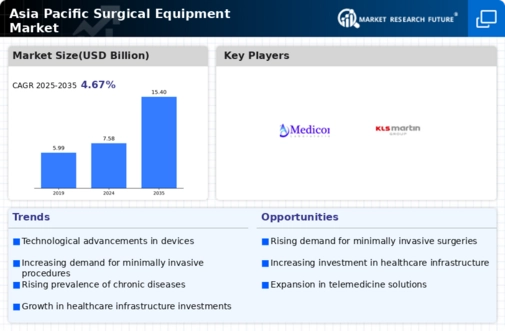Market Share
Asia Pacific Surgical Equipment Market Share Analysis
The Asia Pacific Surgical Equipment market is dynamic and rapidly evolving, necessitating strategic market share positioning strategies. Companies operating in this diverse region deploy various approaches to secure a significant market share and cater to the expanding healthcare needs across Asia Pacific. Reflecting unprecedented cultural differences in Asia Pacific region , products and marketing strategies of all companies are focused on localization. It optimizes acceptance rate through the adaptation of the surgical equipments to culture needs and conventionalism of regional healthcare. Cultural sensitivity promotes belief with the level of market share which wins market with professional people publishing higher trust. In the Asia Pacific region there is a wide variety of healthcare settings each with averaging infrastructure and resources. Recognizing that surgical equipment customizing is required in specific environments, such as large urban hospitals, small rural clinics, and ambulatory surgical centers, companies concentrate their efforts on this aspect. Marvelous flexible solution created benefits of more markets coverage and the demand for the peculiar necessity of the different healthcare surroundings. The economic situation in the Asia Pacific region is characterized by huge disparity; therefore, companies improve strategic pricing models to consider different levels of income. Reason number two is that a variety of tiered pricing structures, discounts, and affordable packages makes the products accessible hence attracts a larger consumer base creating a greater market share. Regional regulatory standards are mandatory. It can be stated that corporate entities ensure that there surgical instrumentation complies or even surpasses the varied regulatory needs across Asia Pacific countries. Today, a strong compliance with quality and safety standards serves as a measure of credibility for products within the market with the credibility further encouraging the trust from the professionals in the healthcare sector while also translating to a rise in the market share. The important is to have investing in educational campaigns and training program. Comapnies offer resources, workshops, and online training materials to the professionals of health care for correct use of the surgical instruments. As a result of education, brand loyalty and preference is developed which affects the purchasing behaviour of people and leads to increase in market share. Building relations with local healthcare groups is a tactical decision. Companies work with hospitals, clinics and healthcare providers to assimilate their surgical equipment into existing healthcare systems. Trying to save time today? outsource your primitive tasks through us. Technology advancements must be accepted in the Asia Pacific market. Emerging firms focus on developing intelligent technologies alongside forward thinking enhancements for their surgical instruments. Sophisticated capabilities appeal to the healthcare providers looking for the latest offerings driving the market share in the becoming technology advanced environment. During distribution network optimization, market penetration crucially involves. Strategy of distribution channels is formulated to make surgical equipment comfortable options eliminating distance across heterogeneous Asian healthcare infrastructure. As efficient distribution improves accessibility of the product, a bigger customer base is attracted, thereby increasing the market share effectively. Good continuous quality improvement must be maintained. According to a research, companies actively request for feedback from Healthcare professionals as well as users to improve product characteristics and reliability. Major market dynamics on which a commitment to quality assurance positively affects customer loyalty dictates market positioning and a resultant increase in market share in the competitive Asia Pacific Surgical Equipment market.





Leave a Comment